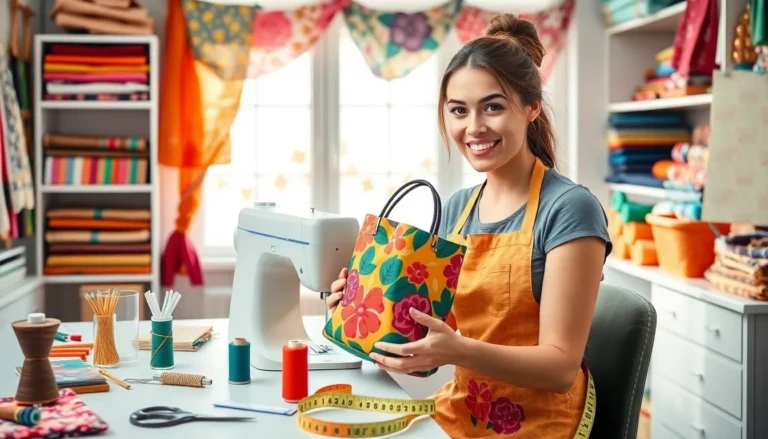Looking to elevate your space without breaking the bank? Wall stenciling might just be the magic trick you need. It’s like giving your walls a makeover with a sprinkle of creativity and a dash of fun. Imagine transforming a dull room into a vibrant masterpiece that’ll have your guests wondering if you hired a professional designer—or if you just have an artistic flair hidden up your sleeve.
Creative Wall Stenciling Ideas
Explore ways to incorporate stencils into home design. Floral patterns add elegance to bedrooms and living rooms. Geometric shapes enhance contemporary aesthetics in open spaces. A nature theme, featuring trees or animals, creates a calm environment in children’s rooms or nurseries.
Opt for a quote stencil on an accent wall to inspire positivity in any space. Use large stencils for a bold statement, or smaller options for understated charm. Monochromatic color schemes maintain a sophisticated look, while vibrant colors energize a space.
Combine different stencil designs for a unique feature wall. Layering stencils creates depth and interest in the overall design. Eyes can be drawn to specific areas through contrasting colors and patterns.
Consider stenciling furniture pieces for a cohesive design. Applying stencils to side tables or cabinets brings creativity and functionality together. Wall stencils can also be used in kitchens, utilizing patterns for backsplashes.
Experiment with textures, using sponges or brushes for added dimension. Matte finishes offer a subtle appearance; glossy finishes create a polished look.
Plan out the layout before starting the stenciling process. Utilizing painter’s tape helps in achieving clean edges and precise lines. Stenciling can serve as a DIY project, allowing for personal expression and creativity.
Use these creative wall stenciling ideas to personalize any living space. By choosing the right designs and colors, anyone can achieve the desired aesthetic efficiently.
Popular Stencil Designs
Wall stenciling offers a variety of designs that can suit different tastes and aesthetics. By choosing the right stencil patterns, individuals can create unique looks tailored to their spaces.
Geometric Patterns
Geometric patterns stand out for their modern appeal. Triangles, hexagons, and squares can transform an ordinary wall into a focal point. These designs often use alternating colors to create depth and interest. Straight lines and clean edges achieve a polished look, making it ideal for contemporary interiors. Combine various shapes for a dynamic effect. Experiment with placement to highlight specific areas. Use painter’s tape for precision during application, ensuring each shape maintains its form. Consider larger patterns for open spaces and smaller designs in tight corners.
Floral Motifs
Floral motifs offer a timeless and elegant charm. Diverse flowers create a soft and inviting atmosphere. Roses, daisies, and leaves can bring nature’s beauty indoors. Choose colors that complement the room’s palette for cohesion. A subtle or bold approach can change the mood drastically. Layering different floral stencils adds complexity and richness to the design. Apply them in clusters for a garden effect or in single, spaced arrangements for a more minimalistic look. Utilize light and dark colors to create contrast.
Choosing the Right Color Palette
Selecting the right color palette serves as a foundational step in wall stenciling. A well-thought-out color scheme adds depth and emotion to stenciled designs, enhancing the overall aesthetic of any room.
Harmonious Color Schemes
Harmonious color schemes promote a seamless blend of shades. Designers often recommend using analogous colors for a soothing effect. For instance, combining soft blues and greens creates a tranquil atmosphere, ideal for bedrooms or relaxation spaces. Natural colors, such as earthy browns with muted greens, further enhance organic designs, especially in children’s rooms. The gentle transition between similar colors allows for creativity while maintaining visual comfort. Using light and airy tones also brightens spaces, making them feel open and inviting.
Bold Contrasts
Bold contrasts command attention and infuse energy into stenciling projects. High-contrast combinations, like navy and gold, serve as striking focal points in living areas. For more playful designs, bright pinks against deep purples create excitement and vibrancy. Utilizing strong contrasts emphasizes stencil patterns, making them pop on the wall. This technique works particularly well for geometric designs, where sharp lines and bold colors create dynamic visuals. Additionally, incorporating black with any bright color anchors the overall look, providing depth and sophistication to interiors.
Tools and Materials Needed
Gathering the right tools and materials is essential for successful wall stenciling. This preparation ensures a smooth and enjoyable process.
Essential Stenciling Tools
Use a variety of essential tools to achieve clean and precise stenciling results. A stencil brush or foam roller applies paint evenly without bleeding. Painter’s tape secures the stencil in place, preventing movement during application. A level keeps stencils straight for consistent alignment. Additionally, a sponge can help create texture or blend colors. Prepare a drop cloth to protect floors and surrounding furniture from paint spills.
Choosing the Right Paint
Selecting the right paint impacts the final appearance of the stenciled design. Opt for high-quality acrylic or latex paint for durability and easy cleanup. Consider using matte finishes for subtle and elegant designs or glossy finishes for bold statements. Explore a variety of colors, ensuring they complement the existing room decor. Test paint samples on a small section of the wall to see the colors in different lighting conditions.
Application Techniques for Stenciling
Effective wall stenciling relies on proper application techniques to ensure professional results. Attention to detail during preparation and execution makes a significant difference in the project outcome.
Preparing Your Wall Surface
Start with a clean wall to prevent imperfections. Dust and dirt can impair paint adhesion. Wash the surface with mild detergent and water, then let it dry completely. Inspect the wall for any holes or imperfections, and patch them with spackle. Sand the patches once dry for a smooth finish. Priming the wall enhances paint adhesion, so use a quality primer, particularly on darker surfaces. When applying primer, seek even coverage for optimal results.
Stenciling Tips and Tricks
Choose the right stencil material for the project. Mylar, reusable stencils resist paint bleed and allow for multiple uses. Secure the stencil firmly to the wall using painter’s tape to prevent shifting. Use a stencil brush or foam roller for controlled paint application, avoiding excess paint that can lead to smudging. Always apply paint lightly, building up layers gradually. Removing the stencil at a consistent angle can prevent dripping and ensures clean edges. Consider working in small sections for precision, especially with intricate designs.
Wall stenciling offers a unique opportunity to express creativity and enhance any space. With the right designs and techniques anyone can transform their walls into stunning focal points. Whether opting for elegant florals or bold geometric patterns the possibilities are endless.
Experimenting with colors and textures adds depth and character to the overall aesthetic. By investing time in planning and execution it’s possible to achieve professional-looking results that reflect personal style. Ultimately wall stenciling not only beautifies a home but also provides a fulfilling creative outlet. Embrace the art of stenciling and watch as ordinary walls become extraordinary showcases of individuality.






